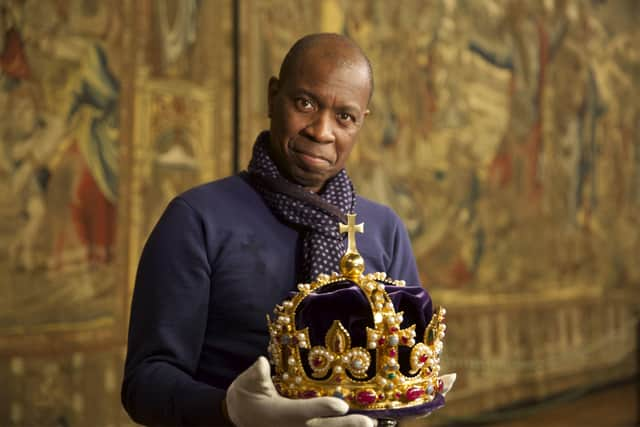Discovering more about the royal Crown Jewels
and live on Freeview channel 276
Made up of 13 crowns and 142 objects set with a staggering 23,578 precious gemstones, the Crown Jewels have been used in royal ceremonies for centuries.
The coronation regalia is the only working set in Europe, and the collection is the most historically complete of any in the world.
Advertisement
Hide AdAdvertisement
Hide AdAs part of this weekend’s Platinum Jubilee celebrations, Clive Myrie has been granted special access to ceremonial objects used to invest and crown British monarchs, which are kept in the Tower of London.


In this revelatory documentary, the Mastermind host, who was in Kyiv reporting on Russia’s invasion of Ukraine in April, travels across Britain, deploying the latest technology, to explore the dramatic stories behind these precious jewels, from Roman and Anglo-Saxon times, long before the coronation of William the Conqueror in 1066, to today.
For nearly a thousand years, the current Crown Jewels have been an integral part of the coronation of Britain’s kings and queens, and have symbolised the power and authority of the monarchy. However, the ceremonial objects are also linked in many ways to Britain’s colonial past, and have been the subject of controversy. One of the most contentious jewels is the Koh-i-Noor diamond, set in the crown of Queen Elizabeth the Queen Mother.
The 105.6-carat stone – the size of a hen’s egg and is one of the largest cut diamonds in the world – was ceded to Queen Victoria in 1849. However, some believe the 10-year-old ruler of Punjab was forced to give it up at the time.
Advertisement
Hide AdAdvertisement
Hide AdIn 2016, the Indian government said it wanted the jewel to be returned, and the governments of Pakistan, Iran, and Afghanistan have also claimed ownership of the Koh-i-Noor.
Hinting that the documentary may cover this and other controversies surrounding some of the jewels, Clive says: “It’s been a really powerful journey of discovery for me, finding out more about the amazing Crown Jewels, their importance to the monarchy and their role in the complex history of our islands.”
This hour-long documentary is seen by the some as a key part of not only the BBC’s programming to mark the Queen’s platinum jubilee, but also their long-term mission to repair the fractured relationship between the Corporation and the Royal Family. Buckingham Palace was furious at the BBC after the full extent of fraudulent methods used by Martin Bashir to secure his 1995 interview with Princess Diana were revealed in a report by Lord Dyson.
Meanwhile, Prince William was also said to be angry at a BBC Two documentary which suggested some of the negative press surrounding Prince Harry and Meghan had been leaked by his own royal household.
Advertisement
Hide AdAdvertisement
Hide AdAccording to the Daily Mirror, an insider apparently said: “Clive has not been involved in any of the recent controversies and is seen as a very safe pair of hands. They are hoping it will help to draw a line under what has gone before.”
However, that will only be the case if the journalist and broadcaster doesn’t discover too many modern-day revelations while investigating the national treasures. Otherwise, neither the royals, or his employer, will be happy.